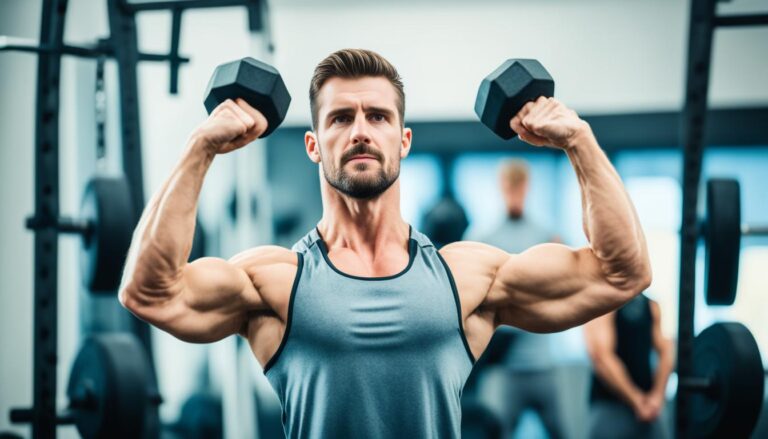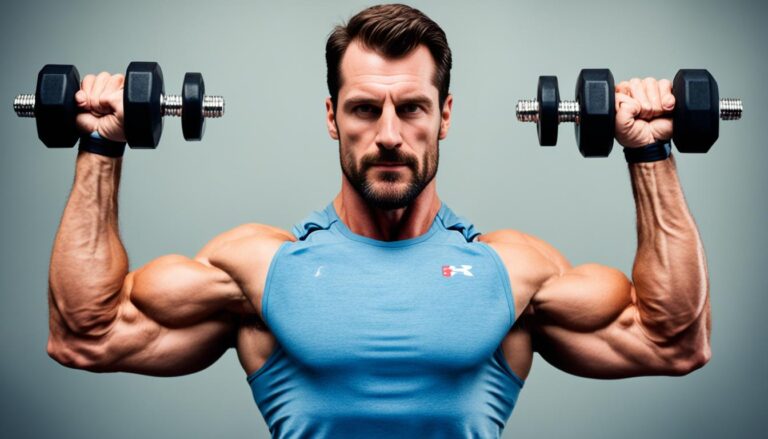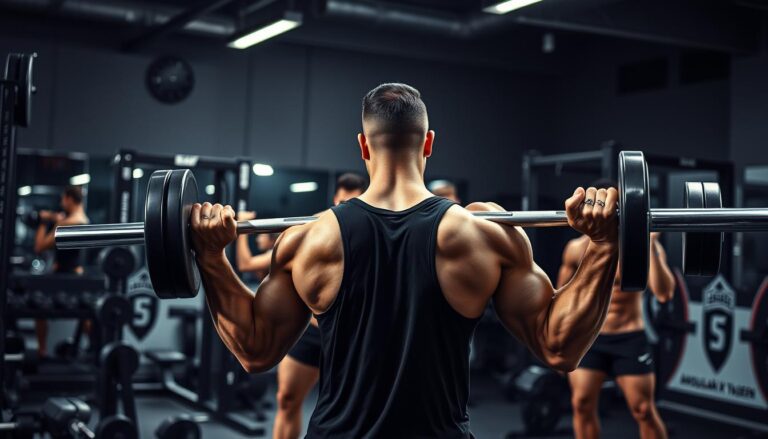If you’re determined to build upper chest muscle efficiently, focusing on targeted exercises with dumbbells is key. Dumbbell workouts for upper chest are immensely effective because they allow for a full range of motion, ensuring each muscle fiber gets the attention it needs. Utilizing dumbbells also enables you to fine-tune imbalances and engage stabilizing muscles, leading to a well-rounded and aesthetically pleasing chest.
This comprehensive guide will walk you through crucial exercises and techniques to build upper chest muscle quickly and effectively. From mastering the incline dumbbell press to experimenting with variations of chest fly exercises, we have you covered. By the end of this article, you’ll master the art of isolating and developing your upper chest with precision and confidence.
Key Takeaways
- Dumbbell workouts for the upper chest provide a full range of motion and precise muscle activation.
- Targeted exercises can address muscle imbalances and stimulate stabilizing muscles.
- Incline dumbbell presses are fundamental for developing the upper chest.
- Experimenting with chest fly variations can further enhance upper chest development.
- Consistent practice will help you master these techniques and build upper chest muscle efficiently.
Why Focus on Upper Chest Workouts?
Focusing on upper chest workouts brings a distinct array of advantages to your fitness regime. By targeting this specific area, you can achieve balanced muscle development, enhanced strength, and improved posture. These elements contribute significantly to creating a visually appealing and well-rounded physique.
The importance of a well-developed upper chest
Upper chest development plays a critical role in creating a balanced and aesthetic look. A prominent upper chest not only enhances your physical appearance by providing a fuller look to your chest area but also contributes to better posture. This is particularly beneficial for individuals who spend extended periods sitting, as it helps counteract the effects of a rounded shoulder posture.
Benefits of targeted upper chest workouts
The benefits of upper pectoral workouts go beyond aesthetics. By incorporating targeted exercises, you can experience improved strength and functionality. This leads to greater stability and control during various physical activities, ranging from daily tasks to intense workout routines. Additionally, emphasizing upper chest development helps in building a symmetrical upper body, which is crucial for reducing the risk of injury and promoting overall muscular harmony.
- Enhanced physical appearance
- Better posture
- Improved strength and functionality
- Greater muscular symmetry
The Anatomy of Your Upper Chest
If you’re aiming to amplify your workout routine, understanding the upper pectorals anatomy is crucial. A thorough grasp of the muscle structure and function will not only enhance your performance but also prevent injuries.
Understanding the Upper Pectorals
The upper chest is predominantly composed of the clavicular head of the pectoralis major. This muscle region attaches to the clavicle and extends to the humerus, facilitating a range of motions essential for upper body exercises. When you engage in upper chest workouts, particularly those involving dumbbells, the clavicular head is significantly activated.
How Upper Chest Muscles Function During Workouts
The muscle function in upper chest workouts is vital for achieving a balanced and well-developed physique. Exercises such as incline dumbbell presses and flyes specifically target the upper pectorals, promoting hypertrophy and strength. During these movements, the clavicular head of the pectoralis major contracts, lifting the upper portion of the chest and shoulders to complete the motion. This targeted engagement is what makes upper chest exercises so effective for muscle development.
Getting Started with Dumbbell Workouts for Upper Chest
Before jumping into your routine, it’s crucial to understand the basics of starting upper chest exercises with dumbbells. First, select the appropriate weight that challenges you but allows proper form. If you’re new, starting with lighter weights while you get the hang of the movements is wise. This minimizes injury risks and ensures you’re targeting the correct muscles.
Next, consider creating a dedicated workout space. Having a bench, a variety of weights, and enough room to move freely will ensure an effective session. Don’t overlook the importance of a safe environment, free from clutter and equipped with a non-slip mat. This preparation will make your dumbbell workouts to develop upper pecs much smoother and more focused.
Incorporating a warm-up is non-negotiable. Dynamic stretches and light cardio, such as jumping jacks or a brisk walk, will increase blood flow to the chest muscles. This primes them for the upcoming workout and reduces the risk of strains. Remember, an adequately warmed-up muscle is more pliable and performs better.
- Selecting weight: Choose a challenging yet manageable weight.
- Creating workout space: Ensure a safe, clutter-free environment with all necessary equipment.
- Warming up: Engage in dynamic stretches and light cardio.
Understanding these preliminary steps will set you up for success in your journey of starting upper chest exercises with dumbbells. Once these elements are in place, you’ll be well-prepared to tackle more advanced exercises and truly benefit from dumbbell workouts to develop upper pecs.
Incline Dumbbell Chest Press for Maximum Gains
The incline dumbbell chest press stands out as one of the most effective exercises for developing a robust upper chest. This powerhouse move targets the upper pectoral muscles, ensuring well-rounded chest development. By mastering the correct form for chest press, you can maximize muscle growth and prevent injuries.
Proper form and technique
Achieving the correct form for chest press is crucial for reaping the maximum benefits of the incline dumbbell chest press. Here’s a step-by-step guide:
- Set up the bench: Adjust the bench to a 30-45 degree angle. This range effectively targets the upper chest without straining the shoulders.
- Position yourself correctly: Lie back on the bench with your feet flat on the floor. Ensure your back is pressed into the bench.
- Grip the dumbbells: Hold a dumbbell in each hand at shoulder level with your palms facing forward.
- Press upwards: Extend your arms and press the dumbbells straight up, ensuring they move in a controlled manner, forming a slight arc.
- Return to start: Lower the dumbbells back to the starting position at shoulder level.
Common mistakes to avoid
Even with the best intentions, it’s easy to fall into bad habits when performing the incline dumbbell chest press. Here are common mistakes to watch out for:
- Incorrect bench angle: Setting the bench too high can shift the focus from the upper chest to the shoulders.
- Arching the back: Maintain a neutral spine to avoid placing unnecessary stress on your lower back.
- Flared elbows: Keep your elbows at a 45-degree angle to protect your shoulder joints.
- Rushing the movement: Controlled, slow movements ensure that the muscles are engaged throughout the exercise.
- Uneven lifting: Ensure both arms press the weights evenly to maintain balance and symmetry.
Avoiding these pitfalls and employing the correct form for chest press will significantly enhance your upper chest workouts, leading to impressive gains over time.
| Common Mistakes | Corrections |
|---|---|
| Incorrect bench angle | Set angle between 30-45 degrees |
| Arching the back | Maintain a neutral spine |
| Flared elbows | Keep elbows at a 45-degree angle |
| Rushing the movement | Perform slow, controlled reps |
| Uneven lifting | Ensure balanced, even presses |
Dumbbell Chest Fly Variations for Upper Chest Development
To maximize the growth and definition of the upper chest, incorporating different dumbbell chest fly variations is essential. Each variation targets the chest muscles from unique angles, ensuring balanced muscle development and preventing routine plateaus.
Here is an informative guide detailing diverse chest fly variations for upper chest gains:
- Incline Dumbbell Chest Fly:
- Set the bench at a 30-45 degree angle to focus on the upper chest.
- Perform the fly movement, ensuring a deep stretch at the bottom and a full contraction at the top.
- Single-Arm Dumbbell Chest Fly:
- Offering improved muscle isolation.
- Also allows for correction of any muscle imbalances.
- Standing Dumbbell Chest Fly:
- Utilizes both cables and dumbbells for an enhanced upper chest stimulus.
- Emphasizes core stability and balance.
Here’s a comparison of the benefits each dumbbell chest fly variation offers:
| Variation | Emphasis | Benefits |
|---|---|---|
| Incline Dumbbell Chest Fly | Upper Chest Focus | Improves overall upper pec delineation and strength |
| Single-Arm Dumbbell Chest Fly | Isolation and Symmetry | Corrects muscle imbalances and provides enhanced muscle control |
| Standing Dumbbell Chest Fly | Full-Body Engagement | Increases core strength and overall stability |
How to Incorporate Dumbbell Pullovers for Upper Chest
Incorporating dumbbell pullovers into your workout routine can significantly enhance the development of the upper chest. This classic exercise not only targets the upper pectoral muscles but also involves other muscle groups, providing a comprehensive upper body workout.

Effective techniques for dumbbell pullovers
Executing dumbbell pullovers with proper technique is vital to ensure maximum effectiveness and prevent injury. Here are some steps you should follow:
- Starting Position: Lie flat on a bench with your feet firmly planted on the ground. Hold a dumbbell with both hands directly above your chest.
- Lowering Phase: Gently lower the dumbbell behind your head while maintaining a slight bend in your elbows. Ensure your back remains in contact with the bench.
- Raising Phase: Return the dumbbell to the starting position through a controlled movement, focusing on engaging your upper chest muscles.
Proper form is crucial when performing dumbbell pullovers for upper chest to avoid strain on the shoulders and back.
Combining pullovers with other exercises
Integrating dumbbell pullovers in workouts can amplify your gains by working multiple muscle groups. Here’s a sample combination that blends well with pullovers:
- Incline Dumbbell Press: Target the upper pectorals directly after the pullovers to intensify the muscle engagement.
- Dumbbell Flyes: these help to further stretch and work the chest muscles.
- Push-Ups: Finish with push-ups to exhaust the chest muscles completely.
By integrating dumbbell pullovers in workouts such as this, you can create a more balanced and effective upper chest routine.
Intense Upper Chest Pump Workouts
Achieving an intense upper chest pump during workouts is a game changer that can significantly enhance muscle hypertrophy, giving you those satisfying gains. The main objective here is to execute workouts that maximize blood flow and engage the upper chest muscles thoroughly.
To kick things off, one of the most effective ways to achieve a chest muscle pump is by incorporating high-intensity exercises into your routine. These workouts not only focus on muscle activation but also ensure a quicker and more effective pump.
- Partial Reps: Performing partial reps on the incline bench press can significantly enhance muscle engagement. By focusing on the top half of the movement, you maintain constant tension on the upper chest.
- Super Sets: Pair exercises like incline dumbbell press with incline dumbbell flies without rest. This method quickly fatigues the muscles and maximizes blood flow.
- Time Under Tension: Extend the eccentric phase (lowering the weight) during your chest workouts. A 3-4 second eccentric phase can lead to greater muscle activation and a powerful pump.
Here’s a detailed comparison of two effective routines to achieve an intense upper chest pump:
| Workout Technique | Description | Advantages |
|---|---|---|
| Drop Sets | Start with a heavy weight and perform sets until failure, then reduce the weight and continue without rest. | Maximizes muscle fatigue and increases time under tension, leading to a deep muscle pump. |
| Pyramid Sets | Increase the weight with each set while decreasing the reps, then reverse the process. | Promotes both strength and hypertrophy, resulting in superior muscle engagement and pump. |
Incorporating these intense upper chest pump workouts will not only help in achieving a chest muscle pump but also contribute significantly to overall upper chest development. Stay consistent and push your limits to see remarkable changes.
Sample Dumbbell Workouts for Upper Chest
Having a structured plan for your upper chest workouts is crucial for consistent progress. Below are detailed workout routines for all levels, ensuring you achieve maximum benefits from your dumbbell workouts for upper chest development.
Beginner Routine
This routine is designed for those just starting their fitness journey. Focus on mastering the basic techniques and maintaining proper form.
- Incline Dumbbell Press: 3 sets of 12 reps
- Incline Dumbbell Flyes: 3 sets of 15 reps
- Push-Ups: 3 sets of 10 reps
- Rest between sets: 60 seconds
Intermediate Routine
For those who have been consistent with their workouts and are looking to challenge themselves further, this routine adds more intensity.
- Incline Dumbbell Press: 4 sets of 10 reps
- Incline Dumbbell Flyes: 4 sets of 12 reps
- Dumbbell Pullovers: 4 sets of 10 reps
- Rest between sets: 45 seconds
Advanced Routine
For seasoned individuals who have built a solid foundation, this advanced routine focuses on heavy lifting and high volume for the ultimate upper chest pump.
- Incline Dumbbell Press: 5 sets of 8 reps
- Incline Dumbbell Flyes: 5 sets of 10 reps
- Dumbbell Pullovers: 5 sets of 8 reps
- Incline Push-Ups: 5 sets to failure
- Rest between sets: 30 seconds
Tips to Maximize Your Dumbbell Workouts
Maximizing dumbbell workouts involves a strategic approach that combines the right exercise techniques with a solid nutritional foundation. This section delves into optimal workout frequency and volume, as well as essential nutritional advice for muscle building.
Optimal Workout Frequency and Volume
Consistently high-impact dumbbell workouts are critical for upper chest development. The key elements include:
- Workout Frequency: For optimal muscle growth, aim for 3 to 4 sessions per week focused on the upper chest. This allows enough time for muscle recovery while sustaining growth stimuli.
- Volume: Incorporate 3 to 4 sets of 8-12 reps per exercise. Adjust the volume to prevent overtraining while ensuring effective muscle engagement.

Nutrition for Muscle Growth
Balancing diet and exercise is vital for muscle growth. Here’s nutritional advice for muscle building to enhance your workouts:
| Macronutrient | Daily Requirement | Food Recommendations |
|---|---|---|
| Protein | 1.6-2.2 g/kg of body weight | Chicken, Fish, Eggs and Plant-based proteins |
| Carbohydrates | 3-4 g/kg of body weight | Whole grains, Vegetables, Fruits |
| Fats | 0.5-1 g/kg of body weight | Avocado, Nuts, Olive oil |
By focusing on the right macronutrients and incorporating these tips for maximizing dumbbell workouts, you’ll set a strong foundation for muscle growth and strength development in your upper chest.
Common Mistakes in Upper Chest Workouts and How to Avoid Them
In ensuring effective upper chest workouts, it’s crucial to recognize common pitfalls. By focusing on avoiding workout mistakes, maintaining correct form, and adhering to appropriate training frequency, you can optimize results and foster muscle growth in a safer manner.
Incorrect Form and Technique
One of the most prevalent errors is improper form. For instance, during an incline dumbbell press, failing to position the bench at the correct angle or using a poor arm path can severely impede progress and increase the risk of injury.
- Avoid bouncing the weights: Maintain a controlled motion to engage the upper pectorals effectively.
- Keep a neutral spine: Ensure your back remains flat against the bench to avoid undue stress on your lower back.
- Proper grip: Use a firm grip on the dumbbells to stabilize movements and maintain control.
Overtraining vs. Effective Training
Another key aspect to consider is overtraining. It’s essential to strike a balance between workout intensity and recovery periods, emphasizing the correct form and training frequency.
- Optimal rest days: Allow ample time for muscle recovery; typically, 48 hours between upper chest workouts is recommended.
- Progressive overload: Gradually increase resistance to keep challenging your muscles without taxing them excessively.
- Listen to your body: Pay attention to fatigue and discomfort, adjusting your routine to avoid burnout and injury.
By focusing on avoiding workout mistakes and emphasizing the correct form and training frequency, you’ll be well on your way to a more effective and safer upper chest training regimen.
Using Progressive Overload for Upper Pecs
Implementing the progressive overload principle is crucial for enhancing upper pec strength. By continually challenging your muscles with increased weight, repetitions, or intensity, you stimulate growth and prevent plateaus. It’s imperative to apply this principle systematically to maximize the benefits for your upper chest muscles.
- Begin with a weight you can comfortably lift for 8-10 repetitions.
- Gradually increase the weight by 5-10% after mastering the current weight.
- Monitor your progress and adjust the volume and intensity accordingly.
- Incorporate varied exercises targeting the upper pecs to avoid adaptation.
- Ensure proper nutrition and rest to support muscle recovery and growth.
Understanding how to customize workouts using the progressive overload principle will directly contribute to enhancing upper pec strength. As you adjust the weight and volume, it’s essential to maintain correct form to avoid injuries and achieve optimal results.
Conclusion
After delving deeply into the realm of upper chest development, we’re reminded of the critical importance of consistency, the precision of form, and the necessity of a balanced workout and nutrition plan. To truly harness the benefits of these upper chest dumbbell workouts, it is paramount to combine dedicated practice with the right techniques discussed throughout this article.
From understanding the anatomy of your upper chest to perfecting key exercises like the incline dumbbell chest press and integrating effective routines, each element contributes to a well-rounded program aimed at achieving your fitness goals. Mistakes in form and overtraining can hinder progress, so it’s crucial to stay mindful and informed as you advance through different workout levels.
My final thoughts on upper chest dumbbell workouts center on putting this knowledge into consistent practice, engaging in progressive overload, and focusing on proper nutrition to fuel muscle growth. By adhering to these principles, you are well on your way to building a stronger, more defined upper chest. Embrace the journey and watch the transformation unfold.
FAQ
What are the best dumbbell workouts to develop the upper chest?
Some of the most effective dumbbell workouts for developing the upper chest include the incline dumbbell chest press, dumbbell chest fly variations, and dumbbell pullovers for upper chest. These exercises target the upper pectorals and enhance muscle growth and definition.
Why is it important to focus on upper chest workouts?
Focusing on upper chest workouts is essential for a well-rounded physique, improved posture, and balanced strength. Targeted exercises help build the upper portion of the pectoral muscles, which can enhance overall appearance and athletic performance.
What is the correct form for an incline dumbbell chest press?
To perform an incline dumbbell chest press correctly, set an incline bench at a 30-45 degree angle. Lie back with a dumbbell in each hand and press them upwards while maintaining a controlled movement. Keep your elbows slightly tucked and avoid locking out your elbows at the top.
How can I avoid common mistakes during upper chest workouts?
Common mistakes include using too much weight, improper form, and overtraining. Focus on using a manageable weight, maintaining proper form, and allowing adequate rest between workouts. This will help prevent injuries and improve workout efficacy.
What are some intense upper chest pump workouts with dumbbells?
Intense upper chest pump workouts include high-rep incline dumbbell chest presses, supersets combining incline presses and flyes, and incorporating techniques like drop sets and rest-pause sets. These methods maximize blood flow and muscle engagement for a powerful pump.
How often should I perform dumbbell workouts for the upper chest?
It is recommended to work out the upper chest 1-2 times per week, allowing for 48-72 hours of recovery between sessions. This frequency helps in muscle growth while preventing overtraining and ensuring sufficient recovery time.
How can dumbbell pullovers benefit my upper chest?
Dumbbell pullovers effectively target the upper pectoral muscles and enhance chest expansion. Proper technique involves lying on a bench with a dumbbell held above your chest and lowering it behind your head before lifting it back to the starting position. This exercise also engages the latissimus dorsi and serratus anterior muscles for overall upper body development.
What nutritional tips can help maximize my upper chest muscle growth?
Consuming a balanced diet rich in protein, healthy fats, and complex carbohydrates is key for muscle growth. Specific foods like lean meats, fish, eggs, nuts, and whole grains provide the necessary nutrients for muscle repair and growth. Additionally, staying hydrated and timing your meals around your workouts can further enhance muscle development.
How can I use progressive overload in my upper chest workouts?
Progressive overload involves gradually increasing the weight, reps, or intensity of your workouts over time. Start with a challenging but manageable weight and incrementally add more weight or reps in subsequent sessions. This principle ensures continuous muscle adaptation and growth in the upper chest.







